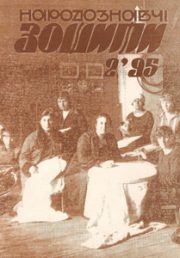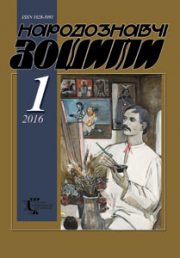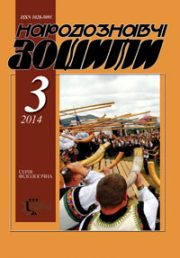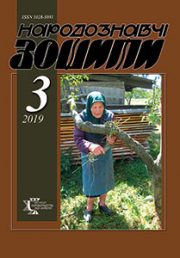The Ethnology Notebooks. 2022. № 3 (165), 601—607
UDK 728.04(477:478)”19″
DOI https://doi.org/10.15407/nz2022.03.601
EVOLUTION OF TRADITIONAL DWELLING DECOR ON THE UKRAINIAN-MOLDOVIAN BORDER IN THE XX-th CENTURY
ZHDANOVYCH Yuliia
- ORCID ID: http://orcid.org/0000-0002-5611-4475
- graduate student department of design
- Kyiv National University of Culture and Arts,
- Department of Design,
- 36, Yevhen Konovalet Str., 01601, Kyiv, Ukraine,
- Contacts: e-mail: Yuliia.rakoiedova@gmail.com
Abstract. Aim of the article. The article analyses role of evolution of decor of traditional dwelling dйcor on the Ukrainian-Moldovian border in the ХХ-th century.
Actuality. The row of typical signs allows to distinguish the traditional accommodation of Ukrainian-Moldavian border in a period of past century in the separate complex of folk accommodation of Ukrainians. At the same time actuality is acquired by development of such complex-analytical estimation criteria.
Research object: Historical and cultural features of the traditional Ukrainian accommodation decor.
Article of research: decor of traditional accommodation in the Ukrainian-Moldavian bordering region.
Chronologic, geographical limits of research. In the article the geographical limits of Ukrainian-Moldovian border are considered in the period of ХХ-th century.
State of theme illumination. Accommodation of many regions that have been investigated along border line have local differences that give an opportunity to educe (in a territorial context) a few variants in particular: north, south and central. In the indicated region painting of accommodation is expedient to name decorative, but not «wall-type», as not only walls but also ceiling signed with certain elements. Both on internal and on external walls there were permanent places of location of painting in a house.
Research methodology. In publications used such methods of research: comparative (at comparison of different elements of decor), typology and descriptive methods of analysis of evolution of decor of traditional accommodation, generalization, complex approach (allowed to subordinate all elements of maintenance and form of the offered article to the aim and tasks of research).
Novelty. It is shown by us, that originality of artistic decision of variants of accommodation on Ukrainian-Moldovian border was stipulated by the report of structural homogeneity of all accommodation with the wide use of the monumental painting.
Conclusions. Character of building, their location, amount, finishing quality, advantage of certain building material both for Ukraine and for Moldova was conditioned first of all by financial possibilities of certain families.
Keywords: decor, traditional dwelling, Ukrainian-Moldovian borderland, borderland, ethnos, ornament, painting, house, material culture.
Received 30.05.2022
REFERENCES
- Moiseenko, Z.V. (1973). Architecture of Rural Residential Houses in Moldova. Kishinev: Kartia Moldoveiasca [in Russian].
- Naulko, V.I. (1975). Development of interethnic relations in Ukraine. Kyiv: Naukova dumka [in Ukrainian].
- Maksymenko, A.A. (Ed.). (2015). Rural areas of the Ukrainian-Romanian borderland: socio-economic development. Lviv: National Academy of Sciences of Ukraine; State Institution «M.I. Nizhnyi Institute of Regional Studies of the National Academy of Sciences of Ukraine»; Romanian Academy of Sciences; Institute of Agrarian Economics [in Ukrainian].
- Strelchuk, N.V., Chuchko, M.K., Bodnaryuk, B.M., & et al. (2018). Ethnocultural and Ethnopolitical Landscape of Border Regions of Ukraine, Moldova, and Romania: Historical Perspective and Current State. Chernivtsi: Technodruk [in Ukrainian].
- Danilyuk, A.G. (1991). Ukrainian House. Kyiv: Naukova dumka [in Ukrainian].
- Kosmina, T.V. (1980). Rural Housing of Podolia, late nineteenth to twentieth centuries: Historical and Ethnographic Study. Acad. of Sciences of the Ukrainian SSR; Institute of Art History; Folklore and Ethnography. Rylsky M.T. Kyiv: Naukova dumka [in Ukrainian].
- Dnestrovsky, M.S. (2008). Ethnogeography of Ukraine. Lviv: Ivan Franko LNU [in Ukrainian].
- Makarchuk, S.A. (Ed.). (1994). The Ethnography of Ukraine. Lviv: Svit [in Ukrainian].
- Peretokin, A.G. (2016). Traditional Ukrainian homestead at the end of the 19th c. — at the beginning of the twentieth century. Bulletin of the Transnistrian State Academy of Civil Engineering and Architecture, 7, 45—55 [in Ukrainian].
- Taras, Y. (2019). Schools of folk temple building, types and groups of carpathian churches. Architectural Studies (Pp. 122—148).
- Petrova, A.O. (2016). Borderland, contact zone: to the question of studying the topic in Ukrainian historiography. Historical archive (Issue 16, pp. 205—209) [in Ukrainian].
- Sherotsky, K. (1914). Artistic decoration of the house in the past and present. Kyiv: Printing house «S.V. Kulzhenko» [in Russian].
- Samoilovich, V.P. (1961). Folk Art in the Architecture of Rural Housing. Kyiv: Derzhbudvydav USSR [in Ukrainian].
- Samoilovich, V.P. (1972). Ukrainian National Housing (late 19th — early 20th century). Kyiv: Naukova dumka [in Ukrainian].
- Yurchenko, P., & Yurchenko, P.G. (1941). Folk Dwelling of Ukraine. Moscow: State Architectural Publishing House of the USSR Academy of Architecture [in Russian].
- Livshits, M.I. (1971). Decor in the Folk Architecture of Moldavia. Kishinev: Stiinza [in Russian].
- (1986). Traditional carving in modern folk architecture of Ukrainian-Moldovian Subnistria. Progressive folk traditions in the enrichment of the Soviet way of life. Collection of scientific works (Pp. 144—153). Kyiv: Naukova dumka [in Ukrainian].







